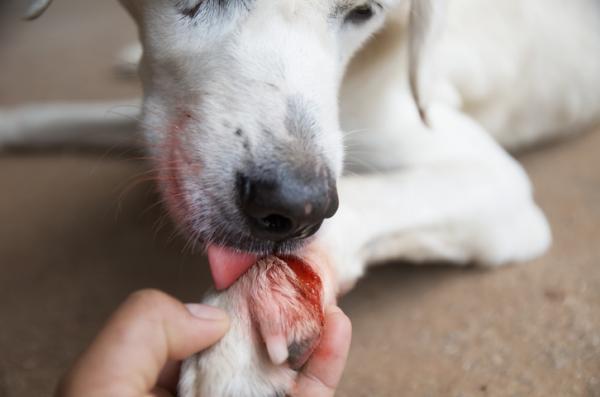What Is Osteomyelitis (Bone Infection) in Dogs?



See files for Dogs
Osteomyelitis in dogs is the inflammation of the bone due to a bacterial or fungal infection. This painful disease will need professional intervention as soon as possible as the treatment takes several weeks to various months, depending on the type of osteomyelitis and its severity.
In this AnimalWised article we're going to talk about what osteomyelitis, also known as bone infection, in dogs is, as well as its common symptoms, causes, types and treatment. Continue reading to learn more!
What is osteomyelitis in dogs?
Osteomyelitis in dogs is the inflammation of the bone due to a bacterial or fungal infection. It is an inflammatory disease of the bone and bone marrow of infectious origin that causes a progressive destruction of bone tissue due to the arrival mainly of bacteria to these areas, triggering inflammation.
Despite the fact that the bone itself is resistant to infections, in this disease there are defects in the blood supply due to enzymes that release the microorganisms that trigger ischemia (an inadequate blood supply to an organ) and necrosis (death of body tissue) of the bone, favoring the cantonment of the microorganisms and the development of the illness.
Itsorigin is mainly bacterial, which can caused by bites, wounds or fractures. It can also be due to a fungal infection, but it usually occurs as a consequence of a generalized fungal disease.

Causes of osteomyelitis in dogs
As we have mentioned, in most cases of canine osteomyelitis the origin is bacterial. According to their frequency, the bacteria involved in the process are:
- Common microorganisms: Staphylococcus aureus, responsible for more than 50% of cases of osteomyelitis in dogs.
- Less common microorganisms: Streptococcus app., Enterococcus spp., Pseudomonas spp., Enterobacter spp., Proteus spp., Escherichia coli and Serratia spp.
- Uncommon microorganisms: Mycobacterium tuberculosis, Mycobacterium avium complex mycobacteria candida spp., Mycoplasma spp., Brucella spp., Salmonella spp. and Actinomyces.
Fungal cases occur much less frequently and occur from systemic fungal diseases, such as aspergillosis, blastomycosis, or cryptococcosis.
Route of entry of infection
Osteomyelitis in dogs is usually caused by external causes (more than 70% of cases), rather than being transmitted through the blood, being this more frequent in puppies. In this way, depending on the arrival of the microorganism to the affected bone, the entry route can be of four types:
- Hematogenous: this type of osteomyelitis is rarely produced from an infection away from the bone, such as the bladder, lung or skin. This is more common in puppies under one year of age and large breeds. In a newborn puppy, septicemia occurs from an umbilical infection that allows bacteria to enter through the arteries that supply the long bones, becoming trapped in arteries and capillaries of the metaphysis of the bones (intermediate part of the bones) at the level of the epiphyseal plate (or growth plate). This causes thrombus, necrosis, migration of leukocytes (white cells of the immune system) and formation of pus within the bone. Osteomyelitis through this route can be directed to the nearest joint, producing septic arthritis (infection of the joint) that must be treated urgently. The bones that are mainly affected are the femur, humerus and vertebrae (discoespondylitis). This form is usually caused by Staphylococcus aureus , although it can also be caused by E. coli, Proteus spp. and Streptococcus spp. Although rare, discoespondylitis can be caused by brucellosis, especially if the dog has contact with ruminant animals or is from a farm.
- Post-traumatic: due to external damage such as bites from other animals, open fractures, gunshots or puncture wounds.
- Tissue contiguity: as when there is an infection in the dog's mouth and it passes to the teeth causing dental osteomyelitis or skin infections, such as chronic deep pyoderma or otitis.
- Latrogenic: due to contamination by trauma surgery. This is because when a bill is surgically set, the implants that are placed in the affected bones are a focal point for bacterial colonization.
Symptoms of osteomyelitis in dogs
In osteomyelitis, the bone initially responds by becoming inflamed and the surrounding soft tissues will be hot, reddish, swollen, and in pain. Depending on its course and origin, it can be acute with systemic signs or chronic without hematological alterations:
Acute osteomyelitis symptoms in dogs
This presentation is the most frequent, where the following clinical signs occur:
- Fever
- Anorexia
- Weight loss
- Increase of cardiac frequency
- Increased white blood cell count (mainly neutrophils)
- Bone pain and swelling due to purulent infection
- Edema of tissues near the lesion with pain on palpation and movement of the affected limb
- Congestion of blood vessels
- Thrombosis in small vessels
Chronic osteomyelitis symptoms in dogs
This clinical form has a longer presence, with clinical signs such as:
- Secretion through fistulas at the injury site
- Lameness
- Muscular atrophy
- Increase in nearby lymph nodes
- Bone tissue with persistent infection
- Bone sequestration formation (segment of dead bone that is separated from living bone by granulation tissue)
If you see your dog is in pain, or if they are experiencing any of these symptoms or other abnormal behaviour, you need to take them to the veterinarian as soon as possible. The sooner they are properly diagnosed, the sooner they will be treated and on their way to healing from this disease. Remember that this disease is very serious and painful. It must be treated by a professional.
Diagnosis of osteomyelitis in dogs
The diagnosis of this disease is made mainly by radiography. With that being sais, the patient's history, as well as the exploration of the area and its analysis, are also indicative of a bone infection. So the diagnosis that your veterinarian will make will be clinical and radiological. Let's take a deeper look into each one of these:
Clinical diagnosis
It is based on doing the following:
- Medical history: previous fractures , bites, foreign bodies, accidents ...
- Physical examination: detect swollen areas, teeth, long bones, spine indicative of a possible bone infection, as well as fever, lethargy, weakness and anorexia.
- Blood test: to find changes indicative of an infectious process such as leukocytosis (increase in white blood cells).
- Analysis of the purulent exudate: with culture and antibiogram to know which is the causative agent and which antibiotic is sensitive to plan medical treatment.
Radiological diagnosis
Radiography is the easiest and cheapest imaging technique to diagnose this disease. However, for bone changes to be seen on the X-ray, there must have been a 30-50% decrease in bone density, which occurs between 10 and 21 days after the onset of the injury (5 to 10 days in puppies). Nearby muscles and soft tissues are the first to be affected. The following changes can be seen on the x-ray:
- Bone lysis (destruction of bone due to infection)
- Periosteal proliferation (formation of new bone)
- Bone sequestration
- Bone resorption (decalcification of the bone)

Canine osteomyelitis treatment
Treatment of osteomyelitis in dogs is based on a surgical treatment in both acute and chronic cases and on a medical treatment with antibiotics or antifungals, depending on the cause.
Surgical treatment of acute osteomyelitis
The infectious focal point must be debrided by removing dead, damaged and infected tissue and washing it thoroughly. If the problem has been that it has been infected due to an implant, then it must be removed, stabilizing the fracture with external fixators that do not cross the bone infection focal point.
Surgical treatment of chronic osteomyelitis
The objective of surgical treatment is to eliminate bone sequestration, heal the area and carry out an abundant and thorough wash to remove all dirt. If it is an unconsolidated fracture and the implants are intact, they should be left as is but monitored frequently with radiographs of the area and removed when the injury heals. Only in the most serious cases is amputation of the affected limb recommended.

Antibiotics for dogs with osteomyelitis
Antibiotic therapy is a mandatory treatment in canine osteomyelitis of bacterial origin. The antibiotic chosen will be the one indicated by the antibiogram, but as a general rule for bacteria such as Staphylococcus, Streptococcus, Enterococcus, Actinomyces or Mycoplasmas, antibiotics such as amoxicillin-clavulanate or ampicillin are usually useful. In contrast, in bacteria such as Pseudomonas spp., Serratia spp., E. coli, Salmonella spp., Brucella, and Proteus spp. Ciprofloxacin or third-generation cephalosporins have a stronger effect.
The antibiotic indicated by the antibiogram is usually applied during the first week and then your dog will take it orally for 4 or 5 more weeks in acute cases; in chronic it can last up to more than six months.
Prognosis of osteomyelitis in dogs
It will depend on the cause that originated it, the severity, if it was due to a fracture that had to be operated on, placing an implant for stabilization and the individual response of each dog. The best thing you can do to help your dog recover as soon as possible is to keep them in a quiet place, away from stress, conflicts with people or other animals, in addition to being properly fed and hydrated and following the treatment guidelines that have been indicated at the veterinary centre.
This article is purely informative. AnimalWised does not have the authority to prescribe any veterinary treatment or create a diagnosis. We invite you to take your pet to the veterinarian if they are suffering from any condition or pain.
If you want to read similar articles to What Is Osteomyelitis (Bone Infection) in Dogs?, we recommend you visit our Infectious diseases category.
- JDC Veterinary Medicine. (2015). Radiological diagnosis of bone infections in the appendicular skeleton of canines and felines. Available at: https://issuu.com/medicinaveterinariajdc/docs/diagn__stico_radiol__gico_de_las_in
- M. Market. Bone diseases Available at: http://www.fvet.uba.ar/fcvanterior/areas/arch_enfquirurgicas/enfermedadeoseas.php
- AVEPA. What is your diagnosis? Available at: https://core.ac.uk/download/pdf/78517148.pdf








